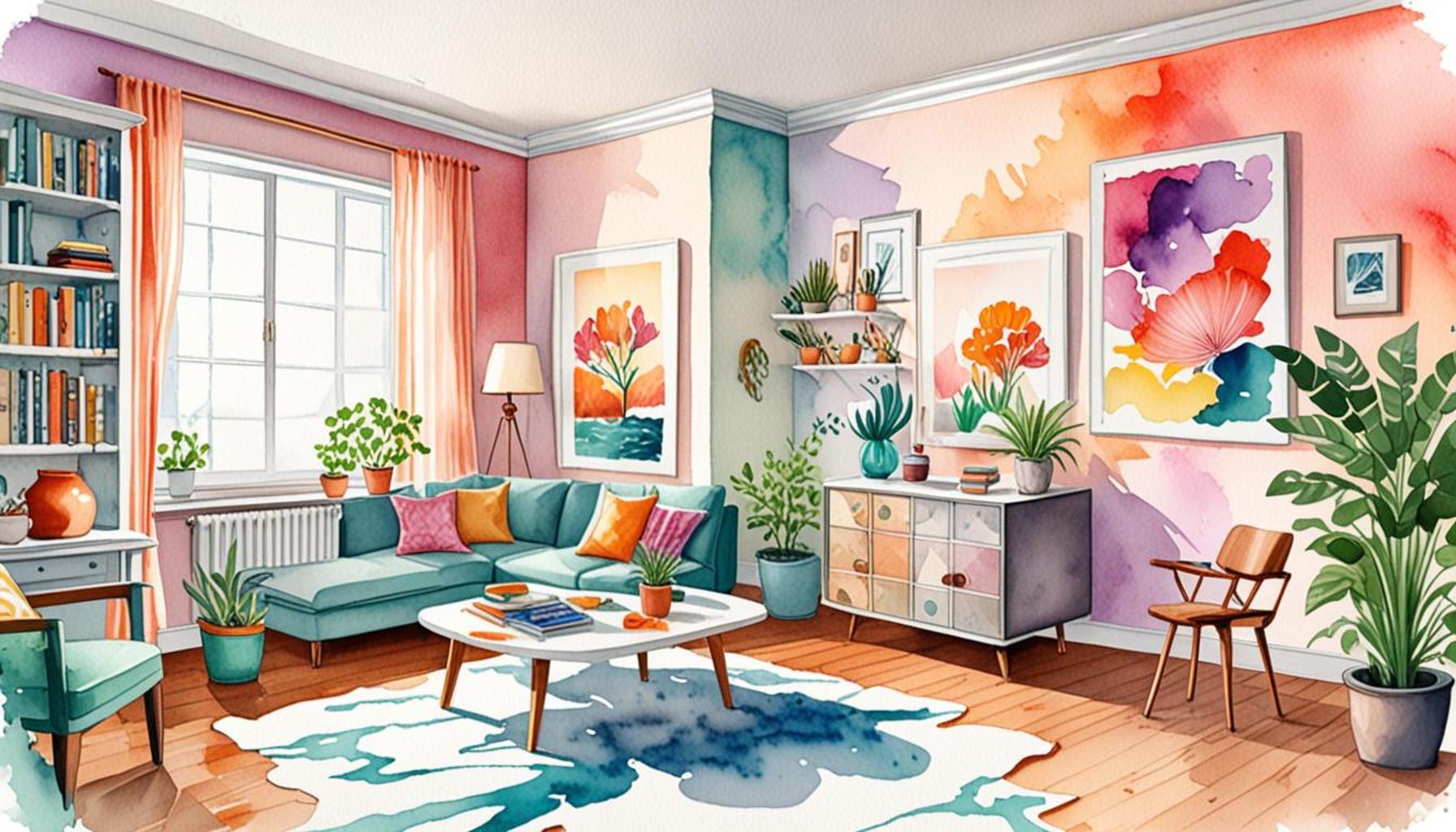Transforming Spaces: How Conscious Intentions Can Guide the Organization of Your Home

Explore the Art of Conscious Organization
Every corner of your home possesses a unique narrative, awaiting your direction. When you adopt a mindset of conscious intentions, you unleash the possibility of crafting a space that resonates with harmony, purpose, and individuality. The process of organization transcends mere tidiness; it becomes a form of self-expression, reflecting your values and lifestyle.
To embark on this transformative journey, consider these impactful elements:
- Decluttering: The act of removing items that no longer serve a purpose in your life can be incredibly liberating. Research shows that excessive clutter can lead to stress and anxiety. Imagine clearing out clothes you haven’t worn in years, or old gadgets gathering dust; this process not only frees up physical space but also creates mental clarity. For instance, in urban Nigerian settings, where space is often limited, having a minimalist approach can maximize your living area and enhance functionality.
- Functional Design: Selecting furniture and arranging layouts to improve your daily routines is essential. For example, incorporating multi-functional furniture, such as a sofa bed or an extendable dining table, can help accommodate family gatherings or visitors, particularly in homes where space must be optimized. Additionally, consider creating designated zones for different activities; workspaces, relaxation areas, and play zones for children can help streamline daily life.
- Color and Light: The right palette and natural light can significantly influence mood and energy levels. Soft, warm colors can create a calming atmosphere, while vibrant hues inspire creativity and dynamism. In Nigeria, where colors often reflect rich cultural identities and histories, incorporating local textiles or artworks can bring both beauty and emotional resonance into your home. Ensure that windows are unobstructed to maximize natural light, which has been linked to better mental health and productivity.
This transformation, however, requires more than just aesthetic adjustments. It demands a comprehensive understanding of the role each item and arrangement plays in your life. Studies have demonstrated that well-organized spaces contribute to improved mental clarity, emotional stability, and overall well-being.
In the vibrant cultural landscape of Nigeria, blending modern organization methods with cultural artifacts can enrich your living space even further. Whether it’s a traditional woven basket or locally crafted pottery, integrating these items into your design not only celebrates heritage but also fosters a deeper connection to your environment. This approach to conscious living is not merely a fleeting trend; it is a pathway to nurturing home spaces that genuinely reflect your values and aspirations.
As we continue this exploration into conscious organization, it becomes clear that the heart of a home lies in the intentions behind its arrangement and decor. Join us as we uncover practical strategies to turn your living space into a sanctuary that supports your lifestyle, nurtures your soul, and tells the story you wish to share with the world.

LEARN MORE: This related article may interest you
Intentional Space: Where Function Meets Emotion
The organization of your home is no longer just a functional need; it is an opportunity to weave your personal narrative into your environment. Conscious intentions provide a framework for understanding how every piece in your space affects not only its physical layout but also your emotional and psychological well-being. Each item you choose to keep or discard should resonate with your lifestyle choices and aspirations, creating a living space imbued with meaning.
To harness the power of conscious organization, consider these essential strategies:
- Mindful Assessment: Begin by evaluating the items in your home. Assess their significance; does each piece evoke joy, functionality, or a sense of comfort? Engaging in a mindful assessment encourages you to focus on incorporating only those items that genuinely enhance your quality of life. In many Nigerian households, heirloom pieces, such as traditional attire or family photographs, often hold sentimental value. Choosing to keep these items can foster a deeper connection to your heritage while promoting a sense of belonging.
- Personalized Zones: Defining the purpose of each area in your home can significantly enhance your daily routines. Consider creating dedicated zones for activities such as work, relaxation, and socializing. The spirit of communal living is deeply embedded in Nigerian culture, where family and friends often gather. By designing spaces that facilitate connection, such as incorporating a cozy sitting arrangement in your living room or a communal dining table, you reinforce bonds and create cherished memories.
- Embrace Nature: Nature’s influence in your space can be profound, not just aesthetically but also psychologically. Integrating plants into your home, especially native species that thrive in Nigeria’s varied climates, can purify the air and enhance your sense of well-being. The presence of greenery has been shown to relieve stress and promote clarity of mind—a vital element in crafting a conscious home environment.
As you begin to weave these strategies into your space, it’s important to recognize that organization is a dynamic process. The intentions you set today may evolve, reflecting changes in your life circumstances or personal growth. The key lies in remaining adaptable; for instance, as your family expands or your work habits shift, your home should be a living reflection of those transitions.
Moreover, the impact of conscious intentions can be remarkably transformative. Research indicates that well-organized spaces correlate positively with increased productivity and decreased stress levels. In the Nigerian context, where daily life can often be chaotic, cultivating a serene home environment offers a sanctuary that not only restores balance but also nurtures creativity.
In embracing the art of conscious organization, you pave the way for a living space that mirrors your identity—a true embodiment of your personal journey and values. The following sections will delve deeper into practical applications of these principles, guiding you step-by-step towards the home sanctuary you’ve always envisioned.
In the journey of transforming your spaces, the principle of conscious intentions plays a crucial role. This approach encourages you to examine not just your physical surroundings but also the emotional and psychological impact of your environment. By discerning your needs and aspirations, you create a living space that resonates with your values and lifestyle.
One practical method to implement this is through mindful decluttering. Consider what items truly serve a purpose in your life and which ones may be taking up valuable space and energy. Engaging in this process allows you to release the non-essential, leading to a more organized and serene atmosphere. It’s about cultivating an environment that fosters creativity, productivity, and peace.
In addition, using intention as a guiding principle can help tailor your home environment to better reflect your dreams and goals. Whether creating a peaceful reading nook or a motivating workspace, aligning your physical environment with your desires enhances your overall well-being. This synergy lays a foundation for growth and transformation within the home, allowing each room to echo the thoughts and feelings you wish to cultivate.
Moreover, integrating elements such as natural light and inviting textures can also enrich your space energetically. Nature-inspired colors and materials not only promote relaxation and healing but can also rejuvenate the spirit. By intentionally selecting these elements, you’re not merely decorating your home; you are curating an experience that elevates your everyday life.
This holistic approach to home organization is not just about aesthetics; it’s about creating a sanctuary that nurtures the body and soul. If you are considering making changes, think deeply about the feelings you want each space to evoke. In your journey to cultivating your home, remember that the most profound transformations often come from within.
| Conscious Intentions | Organizational Benefits |
|---|---|
| Mindful Decluttering | Promotes clarity and reduces stress |
| Intentional Design | Enhances well-being and focus |
Adopting these methods can lead to a more fulfilling home life and open up pathways to discovering your true self through the spaces you inhabit. Embrace the art of conscious home organization and see how it can reshape not only your environment but also your inner landscape.
SEE ALSO: Click here to read another article
Creating Harmony: The Power of Color and Texture
In the journey of transforming your home into a sanctuary reflective of your intentions, color and texture play a pivotal role. The emotional connections we have with different colors rippled through cultures and histories can shape our environment profoundly. For example, in Nigerian culture, colors such as vibrant reds, yellows, and greens signify life and prosperity, while earthy tones can evoke a sense of grounding and stability. Employing a palette that resonates with your personal values can uplift your spirit and energize your space.
Consider creating a harmonious color scheme that complements your lifestyle. Colors can create warmth or openness; for instance, soft blues are known for their calming effects, making them ideal for relaxation spaces like bedrooms. Painting a wall in hues that reflect serenity can provide a welcoming atmosphere after a long day. It’s not merely about aesthetics but nurturing a psychological response that aligns with your vision of home.
Texture is equally important in fostering emotional connections within your spaces. Incorporating varied materials, from soft throws on your couches to the rustic feel of wooden furniture, adds depth and interest. Natural fibers like cotton or linen encourage comfort, while metallic finishes lend a modern touch that may resonate with your aspirations for sophistication. In a communal setting typical of many Nigerian households, using a mix of textures promotes conversation and connection, allowing guests to engage more deeply with the environment.
Indeed, the interplay of color and texture can significantly enhance your home’s ambiance. A well-curated blend not only looks appealing but also impacts your mood and energy levels. For individuals seeking spiritual fulfillment, incorporating symbolic colors or meaningful materials can aid in creating a meditative atmosphere—ideal for spaces dedicated to reflection or prayer.
Conscious Layout: Flow and Energy in Your Home
The layout of your home is akin to the flow of energy in a well-orchestrated symphony. A conscious approach to planning the arrangement of your furniture and belongings ensures that your space does not only serve functional needs but also fosters a positive and inviting atmosphere. A fluid layout can facilitate movement, reduce stress, and enhance the interactions between occupants.
Zoning your home effectively—where each area flows seamlessly into the next—can bolster productivity and relaxation. For example, in a typical Nigerian home, having a central gathering area that connects the kitchen and living room can promote family interaction and hospitality. Deliberately positioning furniture to encourage conversation and connection is key. Arranging chairs and couches in intimate groupings rather than facing outward creates welcoming pockets for family and friends to engage in meaningful dialogue.
Moreover, addressing clutter is vital for energy flow. An organized home fosters clearer thinking and reduces distraction; hence, employing storage solutions that maintain visibility while ensuring items are easily accessible can have a huge effect. For instance, incorporating open shelving for your books or curated decor can allow self-expression while maintaining an organized appearance, resonating with your intentions as both functional and aesthetic.
As you deliberate on your home’s layout, consider how each space aligns with your core values, such as community, creativity, or tranquility. Every decision, from furniture placement to color choices, coalesces to create not just a house but a reflection of who you are and who you aspire to be. Your living space must pivot with your journey, evolving harmoniously as you grow and your intentions shift.
SEE ALSO: Click here to read another article
Final Thoughts: Crafting a Reflection of Your Intentions
In essence, transforming your home into a space that resonates with your personal intentions is both an art and a science. As we’ve explored, the mindful use of color, texture, and a conscious layout can profoundly influence your living environment, enhancing not only its aesthetic appeal but also its emotional significance. The colors you choose and the materials you utilize can create an atmosphere that nurtures your spirit, whether you seek tranquility, creativity, or connection.
Furthermore, considering the flow and energy within your home is crucial in cultivating a harmonious living space. By zoning areas for specific activities and arranging furniture to foster connection, you are not merely organizing your home; you are crafting a reflection of who you are and the values you cherish. This cultural approach, deeply rooted in Nigerian tradition, emphasizes community and inclusivity, shedding light on the importance of shared spaces that encourage unity and dialogue.
As you embark on this journey of home transformation, remember that your space should evolve with you, adapting to your changing intentions and aspirations. By harnessing the power of conscious design, you can create not just a house, but a true sanctuary that embodies your life’s purpose and passions. Take the first step today, and begin to curate a space that tells your story, inviting warmth, connection, and peace into your daily life.


